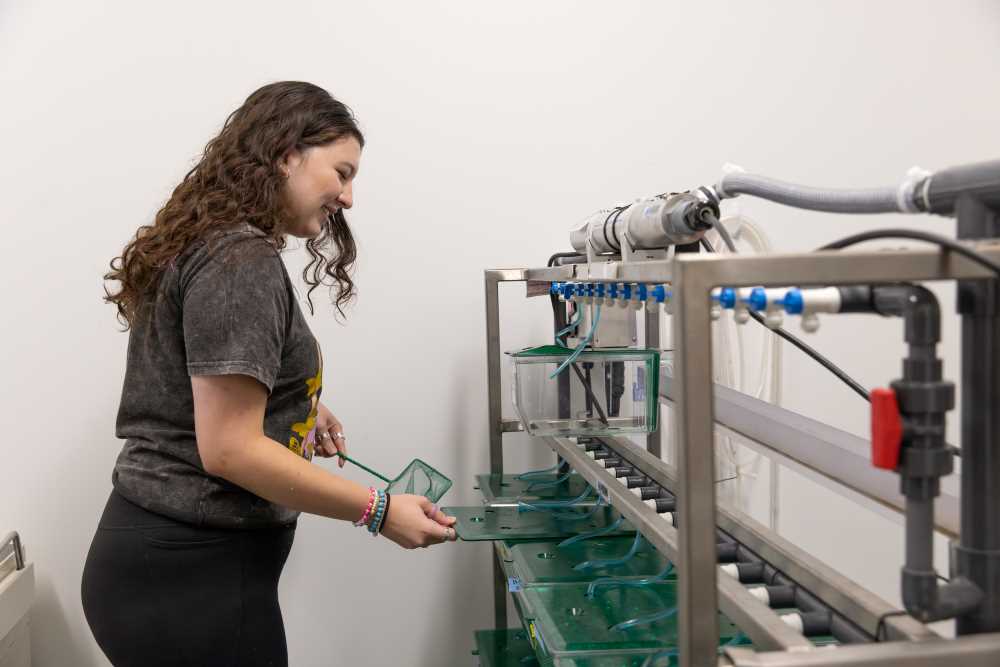Posted 4:42 p.m. Wednesday, June 26, 2024

UWL professor studies fish development to understand PFAS risks for humans, wildlife
As the federal government prepares to enforce new nationwide limits on PFAS in municipal drinking water, UW-La Crosse researcher Dr. Tisha King-Heiden is delving into uncharted territory within this family of toxic chemicals. Her latest research aims to inform regulatory bodies working to establish PFAS limits for surface waters to protect wildlife and fish consumption advisories.
King-Heiden received a $260,000 Wisconsin Sea Grant from the National Oceanic and Atmospheric Administration to explore the bioaccumulation and toxicity of PFAS in several species of larval fish. The two-year study also aims to create culturally-relevant outreach materials for Wisconsin communities.
Perfluoroalkyl and polyfluoroalkyl substances (PFAS) are found in everyday products from shampoo to firefighting foam, and have infiltrated air, soil and water. Nicknamed “forever chemicals,” they don’t readily degrade in the environment or the human body. It is estimated that at least 45 % of America’s tap water now contains PFAS. Exposure to certain levels of PFAS has been linked to serious health issues such as cancer, liver damage and birth defects, among others.
In April, the Environmental Protection Agency (EPA) mandated water providers to reduce six types of PFAS to near-zero levels in tap water.

PFAS are not a new problem, explains King-Heiden. Scientists have been studying these chemicals since the early 1990s. But with over 15,000 different kinds of PFAS, the amount of research to fully understand their impact is overwhelming. Much is still unknown, including the mechanism that causes the damage and effects of environmentally-relevant concentrations on fish. While scientists have found nearly all Americans have some measurable amount of PFAS in their blood, and these chemicals are widely found in adult fish, research hasn’t yet explored PFAS contamination in the early stages of fish development.
King-Heiden’s research fills this gap by investigating how much of these chemicals are absorbed by fish embryos and how this affects their survival. The findings could be predictive of risks for human embryos exposed to PFAS and provide insights into the survival of wild fish populations.
“We can measure PFAS in adult fish, but we don’t know what happens during early stages of fish life,” King-Heiden notes. “If contamination reduces larval survival rates, it could impact survival of the species overall and their ability to sustain their populations in the wild.”
Her research focuses on three PFAS types: PFOS, PFHXS, and F53B. PFOS, produced since the 1960s, are already known to be hazardous but persist in the environment. PFHXS and F53B are newer PFAS with unknown long-term effects, developed as supposedly safer alternatives.
King-Heiden's work involves studying whether the fish embryos' protective chorion layer prevents PFAS from permeating before hatching. She will examine zebrafish and fathead minnows in the lab, as well as several wild fish species like walleye and sturgeon, in collaboration with the Department of Natural Resources (DNR).

The research, which includes UW-La Crosse undergraduate and graduate biology students and a collaborator from UW-Madison, is challenging due to the unknown mechanisms of PFAS toxicity. King-Heiden’s team will expose fish to PFAS concentrations mirroring those found in drinking water and surface waters to examine uptake differences between species, and their impacts on growth, the immune system, nervous system, cardiovascular system and reproduction later in life. As a part of this project, students will also have networking opportunities to learn about careers and graduate programs in water science and aquatic toxicology.
Zebrafish have a lot of the same genes and biological pathways as humans and can be predictive of the effects on humans. King-Heiden is also working with scientists from the Wisconsin Department of Health Services (DHS) to convey her findings.
‘It hits close to home.’

King-Heiden's personal connection to the issue of PFAS strengthens her resolve. She lives on French Island and has been using bottled water for the last few years due to PFAS contamination in the ground water.
“Living with PFAS contamination, it hits close to home,” she says. “When I bought my house 16 years ago, I never considered PFAS – even as a toxicologist. Now, safety limits have drastically changed, and regulatory agencies are trying to understand what that means in terms of providing safe water for communities.”
Her project not only advances scientific understanding but also focuses on public education about PFAS risks related to fish consumption and drinking water. The second year of her grant emphasizes outreach, tailoring information to community needs.
“It’s important that our material comes from the community and addresses their main concerns,” King-Heiden stresses. She’s particularly focused on reaching marginalized groups to ensure they receive clear and relevant information that addresses their needs.
In addition to her new research and outreach on PFAS, King-Heiden is also co-leading the PFAS Collaborator Group for the Freshwater Collaborative of Wisconsin with AJ Jeninga, ’22, a former graduate student. Through the collaboration, UW scientists, government and industry scientists share information and form collaborations that help understand the risks PFAS pose to wildlife and human health. Ultimately, they will provide lawmakers with the information required to make data-informed decisions to best protect Wisconsin's water resources.
